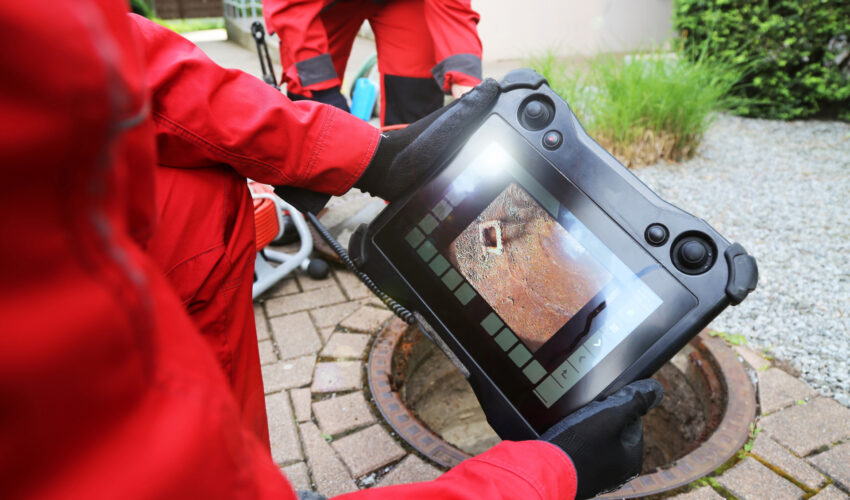When it comes to plumbing problems, what you can’t see might be the most dangerous. From hidden blockages to damaged pipes, many issues lurk deep within your drains, out of sight and out of reach. That’s where video drain inspections come in. Using advanced camera technology, plumbers can peer inside your pipes and reveal problems that would otherwise remain undetected.
Below, we’ll discuss some benefits of video drain inspections and show you exactly what these high-tech cameras can uncover, helping you avoid costly repairs and keep your plumbing system flowing smoothly.
What is a video drain inspection?
A video drain inspection involves running a camera into the building drain line to diagnose a problem. The process is pretty straightforward: the camera is on a snake, like an auger, and uses sonar for locating purposes. Cameras come in an array of sizes to fit pipes of all diameters, allowing for inspection of the entire plumbing system if needed.
What common issues can be found with a video drain inspection?
When a sewer line is clogged, you can run an auger to break up or push the blockage through. But when the same problem keeps occurring, a video inspection can be useful because you can actually see and record what is causing the blockage. Understanding the issue can bring you one step closer to addressing it. The most common things we find during video inspections are (1) breaks in the pipe, (2) roots, (3) bellies, and (4) grease.
Breaks
Breaks can occur from faulty installation, corroded pipes, or a shifting foundation. If these breaks occur under your house, you’ll need to dig a tunnel for the repair. This can cause more damage and be quite expensive. To avoid unnecessary digging, it’s best to first use a camera to pinpoint the problem.
If your pipes are corroded, you may need to replace the entire drain system under the building. If this isn’t a viable option, we can do spot testing to fill sections of the drain; this helps us prioritize which sections to replace first. At North East Air Conditioning, Heating & Plumbing, we’ve developed a way to spot test drain lines with high levels of accuracy, helping you save money on big repairs.
Roots
Roots infiltrate pipes through small leaks, due to either older plumbing materials, like cast iron or clay pipes, or from faulty installation, such as improper glue joints. Once roots find their way in, they’ll continue to grow toward the fertilizer that flows through sewer pipes, expanding the opening and exacerbating the issue. If left untreated, they can compromise sections of your home’s piping. Though you can run an auger to cut the roots, unless you repair the pipe the roots will only continue to grow back.
Bellies
Bellies are sections of pipe that sag or have backfall, sloping toward your home rather than to the main sewer line, often caused by a shifting or unsettled foundation. These dips hold standing water and trap solid waste and, most commonly, grease. Reminder: grease is never meant to go down the drain. Even in pipes without bellies, grease can easily create major blockages.
Depending on where the belly is located, you can prevent major issues by keeping the pipe clean and by not putting too many solids in the pipe. However, if too much debris accumulates and continues to block your drainage or if the sagging is too severe, you’ll need to replace that portion of pipe.
When should you schedule a video drain inspection?
Along with helping you diagnose clogs or slow drains, a camera can be used to help diagnose a failed hydrostatic test when you’re buying a house or leveling a foundation.
A hydrostatic test determines if your building’s sewer drain system holds water, which tells you if there are any leaks in the system. It’s always a good idea to do this when buying a home; even though the cost of the test will likely come out of your pocket, it’s well worth it to help prevent expensive sewer repairs down the line.
Many foundation companies will require hydrostatic tests in order to warranty their work because they don’t want to be blamed for pre-existing sewer problems. If these tests fail, we use a video drain inspection to determine where the leak is. And with North East’s spot testing capability, we can drill down to the exact location of the problem to help avoid a costly diagnosis or repair.
Finally, cameras can be used as locators to determine where exactly sewer pipes are. We most commonly see this request from homeowners looking to do some serious landscaping, but aren’t sure exactly where the drain runs. When you “call before you dig” to locate utilities around your house, they only show power, gas, and telecommunication lines. To avoid running into any plumbing lines, call a plumber.
In Conclusion
Whether you’re dealing with plumbing issues, planning a landscaping project, or purchasing a home, contact North East for your inspection needs. Our spot testing service can help diagnose any potential problems lurking in your pipes, and our experienced technicians can work with you to see what repairs are needed.


